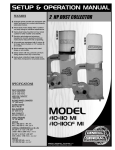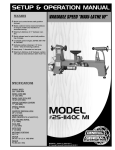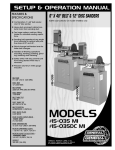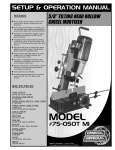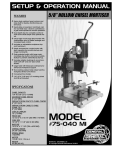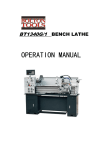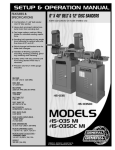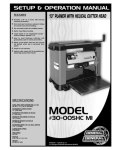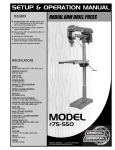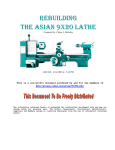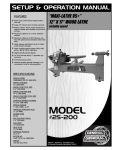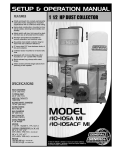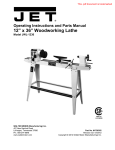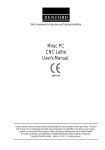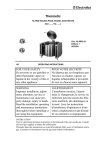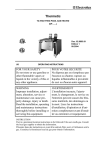Download General International 25-650ABC M1 Use and Care Manual
Transcript
SETUP & OPERATION MANUAL FEATURES 16” x 42” WOOD TURNING LATHE Specifically designed and built for professionals who want superior performance. Heavy-duty, cast-iron bed and stand for added stability and minimal vibration. Headstock swivels 360° with positive stops at 45°, 90°, 135°, 180° and 270° and quicklock for outboard turning. Electronic inverter for variable speed adjustment between 45 and 3750 RPM. Digital spindle speed readout. Forward or reverse rotation. Movable emergency switch can be placed to suit the operator. Quiet, highly efficient, low power consumption motor. Low/High speed change lever for quick belt position changing. 14” tool rest and a 6” face plate included. SPECIFICATIONS SPINDLE SPEEDS (VARIABLE) 45 - 1000, 85 - 2000, 150 - 3750 RPM SWING OVER BED CAPACITY 16” (406 MM) SWING OVER TOOL REST CAPACITY 14” (356 MM) DISTANCE BETWEEN CENTERS 43” (1092 MM) SPINDLE THREAD 1 1⁄4” (32 MM) - 8 TPI TAILSTOCK THROUGH HOLE 3⁄8” (10 MM) HEADSTOCK TAPER MT2 SPINDLE CENTER LINE TO FLOOR 44 1⁄2” (1130 MM) HEADSTOCK MOVEMENT PIVOT 360° AND SLIDE INDEXING POSITIONS 36 X 10° MODEL #25-650ABC M1 OVERALL DIMENSIONS (L X W X H) 64” X 15” X 48” (1626 X 381 X 1219 MM) MOTOR 2 HP, 220 V, 3 PH, 6.2 A INPUT POWER 110 V, 1PH ONLY WEIGHT 418 LBS (190 KG) VERSION 1_REVISION 1 - SEPTEMBER 13/11 (25905211) © Copyright General® International 09/2011 GENERAL® INTERNATIONAL 8360 Champ-d’Eau, Montreal (Quebec) Canada H1P 1Y3 Telephone (514) 326-1161 • Fax (514) 326-5555 • www.general.ca THANK YOU for choosing this General® International model 25-650ABC M1 16” X 42” Wood Lathe. This wood lathe has been carefully tested and inspected before shipment and if properly used and maintained, will provide you with years of reliable service. For your safety, as well as to ensure optimum performance and trouble-free operation, and to get the most from your investment, please take the time to read this manual before assembling, installing and operating the unit. The manual’s purpose is to familiarize you with the safe operation, basic function, and features of this wood lathe as well as the set-up, maintenance and identification of its parts and components. This manual is not intended as a substitute for formal woodworking instruction, nor to offer the user instruction in the craft of woodworking. If you are not sure about the safety of performing a certain operation or procedure, do not proceed until you can confirm, from knowledgeable and qualified sources, that it is safe to do so. Once you’ve read through these instructions, keep this manual handy for future reference. Disclaimer: The information and specifications in this manual pertain to the unit as it was supplied from the factory at the time of printing. Because we are committed to making constant improvements, General® International reserves the right to make changes to components, parts or features of this unit as deemed necessary, without prior notice and without obligation to install any such changes on previously delivered units. Reasonable care is taken at the factory to ensure that the specifications and information in this manual corresponds with that of the unit with which it was supplied. However, special orders and “after factory” modifications may render some or all information in this manual inapplicable to your machine. Further, as several generations of this model of wood lathe and several versions of this manual may be in circulation, if you own an earlier or later version of this unit, this manual may not depict your machine exactly. If you have any doubts or questions contact your retailer or our support line with the model and serial number of your unit for clarification. GENERAL® & GENERAL® INTERNATIONAL WARRANTY All component parts of General®, General® International and Excalibur by General International ® products are carefully inspected during all stages of production and each unit is thoroughly inspected upon completion of assembly. Limited Lifetime Warranty Because of our commitment to quality and customer satisfaction, General® and General® International agree to repair or replace any part or component which upon examination, proves to be defective in either workmanship or material to the original purchaser for the life of the tool. However, the Limited Lifetime Warranty does not cover any product used for professional or commercial production purposes nor for industrial or educational applications. Such cases are covered by our Standard 2-year Limited Warranty only. The Limited Lifetime Warranty is also subject to the “Conditions and Exceptions” as listed below. Standard 2-Year Limited Warranty All products not covered by our lifetime warranty including products used in commercial, industrial and educational applications are warranted for a period of 2 years (24 months) from the date of purchase. General® and General® International agree to repair or replace any part or component which upon examination, proves to be defective in either workmanship or material to the original purchaser during this 2-year warranty period, subject to the “conditions and exceptions” as listed below. To file a Claim To file a claim under our Standard 2-year Limited Warranty or under our Limited Lifetime Warranty, all defective parts, components or machinery must be returned freight or postage prepaid to General® International, or to a nearby distributor, repair center or other location designated by General® International. For further details call our service department at 1-888949-1161 or your local distributor for assistance when filing your claim. Along with the return of the product being claimed for warranty, a copy of the original proof of purchase and a “letter of claim” must be included (a warranty claim form can also be used and can be obtained, upon request, from General® International or an authorized distributor) clearly stating the model and serial number of the unit (if applicable) and including an explanation of the complaint or presumed defect in material or workmanship. CONDITIONS AND EXCEPTIONS: This coverage is extended to the original purchaser only. Prior warranty registration is not required but documented proof of purchase i.e. a copy of original sales invoice or receipt showing the date and location of the purchase as well as the purchase price paid, must be provided at the time of claim. Warranty does not include failures, breakage or defects deemed after inspection by General® or General® International to have been directly or indirectly caused by or resulting from; improper use, or lack of or improper maintenance, misuse or abuse, negligence, accidents, damage in handling or transport, or normal wear and tear of any generally considered consumable parts or components. Repairs made without the written consent of General® Internationallwill void all warranty. TABLE OF CONTENTS Rules for safe operation . . . . . . . . . . . . . . . . . . . . . . . . . . . . . . . . . . . . . . . . . . . . . . . . . . . . . .5 Electrical requirements . . . . . . . . . . . . . . . . . . . . . . . . . . . . . . . . . . . . . . . . . . . . . . . . . . . . . .6 Grounding instructions . . . . . . . . . . . . . . . . . . . . . . . . . . . . . . . . . . . . . . . . . . . . . . . . . . . . . . . . . . . . . . . . . . . . . . . . . .6 Circuit capacity . . . . . . . . . . . . . . . . . . . . . . . . . . . . . . . . . . . . . . . . . . . . . . . . . . . . . . . . . . . . . . . . . . . . . . . . . . . . . . . .6 Extension cords . . . . . . . . . . . . . . . . . . . . . . . . . . . . . . . . . . . . . . . . . . . . . . . . . . . . . . . . . . . . . . . . . . . . . . . . . . . . . . . .6 Basic functions . . . . . . . . . . . . . . . . . . . . . . . . . . . . . . . . . . . . . . . . . . . . . . . . . . . . . . . . . . . .6 Identification of main parts and components . . . . . . . . . . . . . . . . . . . . . . . . . . . . . . . . . . . . . . .7 Unpacking . . . . . . . . . . . . . . . . . . . . . . . . . . . . . . . . . . . . . . . . . . . . . . . . . . . . . . . . . . . . . . . .8 List of contents . . . . . . . . . . . . . . . . . . . . . . . . . . . . . . . . . . . . . . . . . . . . . . . . . . . . . . . . . . . . . . . . . . . . . . . . . . . . . . . . .8 Additionnal requirements for set-up . . . . . . . . . . . . . . . . . . . . . . . . . . . . . . . . . . . . . . . . . . . . . . . . . . . . . . . . . . . . . . .8 Clean up . . . . . . . . . . . . . . . . . . . . . . . . . . . . . . . . . . . . . . . . . . . . . . . . . . . . . . . . . . . . . . . . .8 Placement within the shop . . . . . . . . . . . . . . . . . . . . . . . . . . . . . . . . . . . . . . . . . . . . . . . . . . . .9 Lifting and handling the machine . . . . . . . . . . . . . . . . . . . . . . . . . . . . . . . . . . . . . . . . . . . . . . . . . . . . . . . . . . . . . . . .9 Assembly instructions . . . . . . . . . . . . . . . . . . . . . . . . . . . . . . . . . . . . . . . . . . . . . . . . . . . . . . .10 Install the belt tension release lever . . . . . . . . . . . . . . . . . . . . . . . . . . . . . . . . . . . . . . . . . . . . . . . . . . . . . . . . . . . . . .10 Installing the tool rest swivel arm . . . . . . . . . . . . . . . . . . . . . . . . . . . . . . . . . . . . . . . . . . . . . . . . . . . . . . . . . . . . . . . .10 Basic adjustments & controls . . . . . . . . . . . . . . . . . . . . . . . . . . . . . . . . . . . . . . . . . . . . . . .10-16 Connecting to a power source . . . . . . . . . . . . . . . . . . . . . . . . . . . . . . . . . . . . . . . . . . . . . . . . . . . . . . . . . . . . . . . . . .10 On / Off power switch . . . . . . . . . . . . . . . . . . . . . . . . . . . . . . . . . . . . . . . . . . . . . . . . . . . . . . . . . . . . . . . . . . . . . . . . . .11 Movable emergency switch . . . . . . . . . . . . . . . . . . . . . . . . . . . . . . . . . . . . . . . . . . . . . . . . . . . . . . . . . . . . . . . . . . . .11 Forward / Reverse switch . . . . . . . . . . . . . . . . . . . . . . . . . . . . . . . . . . . . . . . . . . . . . . . . . . . . . . . . . . . . . . . . . . . . . . .11 Starting / Stopping the lathe . . . . . . . . . . . . . . . . . . . . . . . . . . . . . . . . . . . . . . . . . . . . . . . . . . . . . . . . . . . . . . . . . . . .11 Changing spindle speed range . . . . . . . . . . . . . . . . . . . . . . . . . . . . . . . . . . . . . . . . . . . . . . . . . . . . . . . . . . . . . . . . .11 Changing spindle speed . . . . . . . . . . . . . . . . . . . . . . . . . . . . . . . . . . . . . . . . . . . . . . . . . . . . . . . . . . . . . . . . . . . . . . .12 Tool rest carriage & swivel arm and tool rest adjustments . . . . . . . . . . . . . . . . . . . . . . . . . . . . . . . . . . . . . . . . . . .12 Mounting & removing the headstock spur center . . . . . . . . . . . . . . . . . . . . . . . . . . . . . . . . . . . . . . . . . . . . . . . . . .13 Mounting & removing the tailstock live center . . . . . . . . . . . . . . . . . . . . . . . . . . . . . . . . . . . . . . . . . . . . . . . . . . . . .13 Moving tailstock quill in / out . . . . . . . . . . . . . . . . . . . . . . . . . . . . . . . . . . . . . . . . . . . . . . . . . . . . . . . . . . . . . . . . . . .13 Tailstock movement . . . . . . . . . . . . . . . . . . . . . . . . . . . . . . . . . . . . . . . . . . . . . . . . . . . . . . . . . . . . . . . . . . . . . . . . . . .14 Alignment between centers . . . . . . . . . . . . . . . . . . . . . . . . . . . . . . . . . . . . . . . . . . . . . . . . . . . . . . . . . . . . . . . . . . . . .14 Headstock, tool rest carriage and tailstock locking lever adjustment . . . . . . . . . . . . . . . . . . . . . . . . . . . . . . . . .14 Mounting a workpiece to the face plate . . . . . . . . . . . . . . . . . . . . . . . . . . . . . . . . . . . . . . . . . . . . . . . . . . . . . . . . .15 Pivoting the headstock (for outboard turning) . . . . . . . . . . . . . . . . . . . . . . . . . . . . . . . . . . . . . . . . . . . . . . . . . . . . .15 Indexing . . . . . . . . . . . . . . . . . . . . . . . . . . . . . . . . . . . . . . . . . . . . . . . . . . . . . . . . . . . . . . . . . . . . . . . . . . . . . . . . . . . . .15 Periodic Maintenance . . . . . . . . . . . . . . . . . . . . . . . . . . . . . . . . . . . . . . . . . . . . . . . . . . . . . . .16 Recommended optional accessories . . . . . . . . . . . . . . . . . . . . . . . . . . . . . . . . . . . . . . . . . . . .17 Parts list & diagrams . . . . . . . . . . . . . . . . . . . . . . . . . . . . . . . . . . . . . . . . . . . . . . . . . . . . . .18-22 RULES FOR SAFE OPERATION To help ensure safe operation, please take a moment to learn the machine’s applications and limitations, as well as potential hazards. General® International disclaims any real or implied warranty and holds itself harmless for any injury that may result from improper use of its equipment. 1. Do not operate the wood lathe when tired, distracted, or under the effects of drugs, alcohol or any medication that impairs reflexes or alertness. 2. The working area should be well lit, clean and free of debris. 3. Keep children and visitors at a safe distance when the wood lathe is in operation; do not permit them to operate the wood lathe. 4. Childproof and tamper proof your shop and all machinery with locks, master electrical switches and switch keys, to prevent unauthorized or unsupervised use. 5. Stay alert! Give your work your undivided attention. Even a momentary distraction can lead to serious injury. 6. Fine particulate dust is a carcinogen that can be hazardous to health. Work in a well-ventilated area and whenever possible use a dust collector and wear eye, ear and respiratory protection devices. 7. Do not wear loose clothing, gloves, bracelets, necklaces or other jewelry while the wood lathe is in operation. Wear protective hair covering to contain long hair and wear non-slip footwear. 8. Be sure that adjusting wrenches, tools, drinks and other clutter are removed from the machine before operating. 9. Keep hands well away from the spindle, the spin ning workpiece, and all moving parts. Use a brush, not hands, to clear away chips and dust. 10. Do not use stock containing defects such as checks, splits, cracks, knots or foreign objects. Before starting, inspect stock and remove all foreign objects such as dirt, nails, staples or any object that could damage a tool or become dislodged and fly free and cause injury. 11. Select appropriate turning speed for the size and type of workpiece being turned and use lowest speed when starting a new workpiece. 12. Before turning on the wood lathe, make sure the workpiece is securely installed between centers and that all locking levers and moveable or removable parts are tightened down and secured. 13. Adjust the cutting tool parallel and as close as possible to the workpiece and, before starting the lathe, turn the workpiece by hand, at least one full rotation to make sure that it does not come in contact with the cutting tool. 14. Maintain turning tools with care. Keep turning tools sharp and clean for best and safest performance. 15. Avoid working from awkward or off balance positions. Do not overreach and keep both feet on floor. 16. Keep guards in place and in working order. If a guard must be removed for maintenance or cleaning be sure it is properly re-attached before using the tool again. 17. Use of parts and accessories NOT recommended by GENERAL INTERNATIONAL may result in equipment malfunction or risk of injury. 18. Never stand on machinery. Serious injury could result if the tool is tipped over. 19. Always disconnect the tool from the power source before servicing, changing accessories, performing any maintenance or cleaning, or if the machine will be left unattended. 20. Make sure that switch is in the “OFF” position before plugging in the power cord. 21. Make sure the tool is properly grounded. If equipped with a 3-prong plug it should be used with a three-pole receptacle. Never remove the third prong. 22. Do not use this wood lathe for other than its intended use. If used for other purposes, GENERAL INTERNATIONAL disclaims any real implied warranty and holds itself harmless for any injury, which may result from that use. 5 ELECTRICAL REQUIREMENTS BEFORE CONNECTING THE MACHINE TO THE POWER SOURCE, VERIFY THAT THE VOLTAGE OF YOUR POWER SUPPLY CORRESPONDS WITH THE VOLTAGE SPECIFIED ON THE MOTOR I.D. NAMEPLATE. A POWER SOURCE WITH GREATER VOLTAGE THAN NEEDED CAN RESULT IN SERIOUS INJURY TO THE USER AS WELL AS DAMAGE TO THE MACHINE. IF IN DOUBT, CONTACT A QUALIFIED ELECTRICIAN BEFORE CONNECTING TO THE POWER SOURCE. THIS TOOL IS FOR INDOOR USE ONLY. DO NOT EXPOSE TO RAIN OR USE IN WET OR DAMP LOCATIONS. that is close to its amperage draw capacity. However, if an unusual amperage draw does not exist and a power failure still occurs, contact a qualified technician or our service department. EXTENSION CORDS A B C GROUNDING INSTRUCTIONS If you find it necessary to use an extension cord with your machine, use only 3-wire extension cords that have 3- prong grounding plug and a matching 3-pole receptacle that accepts the tool’s plug. Repair or replace a damaged extension cord or plug immediately. In the event of an electrical malfunction or short circuit, grounding reduces the risk of electric shock. Though equipped with a 220V 3 phase motor, due to the electronic frequency inverter this machine is wired for 110V single phase operation and is equipped with a 3-conductor cord and a 3-prong grounding plug A to fit a grounded type receptacle B. Do not remove the 3rd prong (grounding pin) to make it fit into an old 2-hole wall socket or extension cord. If an adaptor plug is used, it must be attached to the metal screw of the receptacle C. Make sure the cord rating is suitable for the amperage listed on the motor I.D. plate. An undersized cord will cause a drop in line voltage resulting in loss of power and overheating. The accompanying chart shows the correct size extension cord to be used based on cord length and motor I.D. plate amp rating. If in doubt, use the next heavier gauge. The smaller the number, the heavier the gauge. Note: The use of an adaptor plug is illegal in some areas. Check your local codes. If you have any doubts or if the supplied plug does not correspond to your electrical outlet, consult a qualified electrician before proceeding. AMPERES (AMPS) 25 FEET 50 FEET 100 FEET 150 FEET <5 18 16 16 14 6 TO 10 18 16 14 12 10 TO 12 16 16 14 12 12 TO 16 14 12 * NR * NR CIRCUIT CAPACITY Make sure that the wires in your circuit are capable of handling the amperage draw from your machine, as well as any other machines that could be operating on the same circuit. If you are unsure, consult a qualified electrician. If the circuit breaker trips or the fuse blows regularly, your machine may be operating on a circuit EXTENSION CORD LENGTH * NR = Not Recommended BASIC FUNCTIONS This General International model 25-650ABC M1 Wood Lathe is designed specifically for medium to larger sized wood turning projects. With a maximum swing over bed of 16”, a distance between centers of 42”, and 3 electronically controlled variable speed ranges (45-1000, 85-2000 and 150 -3750 RPM) with digital spindle speed display, the 25-650ABC M1 is ideal for turnings such as chair or table legs and columns, as well as bowls of various sizes. A simple belt re-positioning on the drive pulleys, allows the operator to select the desired speed range and the electronic speed controller allows for further fine-tuning within each speed range. With its pivoting head, larger bowls can also be turned on the outboard side of the lathe. For longer turnings an optional 18” bed extension, #25-618 can be added. The 25-650ABC M1 comes equipped with a selection of the most commonly used accessories, including a 6” face plate for bowl turning and both live and spur center for typical spindle turning, to allow the user to begin turning (turning tools not supplied) after a few minutes of assembly and set-up, right out of the box. The 25-650ABC M1 is designed to be compatible with all aftermarket turning accessories using MT#2 Morse taper in both headstock and tailstock and the headstock spindle threads are compatible with all 1-1/4” dia x 8 TPI female threaded chucks and face plates. 6 16" X 42" WOOD TURNING LATHE 25-650ABC M1 IDENTIFICATION OF MAIN PARTS AND COMPONENTS U T V W X HEADSTOCK C B D A E A- MOTOR N- TOOL REST B- HEADSTOCK O- TOOL REST SWIVEL ARM C- BELT TENSION RELEASE LEVER M F D- INDEXING PIN E- SPUR CENTER G H K L J TOOL REST I O P Q N F- FACE PLATE Q- TOOL REST CARRIAGE LEVER G- SPINDLE SPEED READ OUT R- TOOL REST CARRIAGE H- VARIABLE SPEED CONTROL KNOB S- TOOL REST LOCKING LEVER I- HEADSTOCK PIVOT LOCKING PIN T- LIVE CENTER J- FORWARD / REVERSE SWITCH V- TAILSTOCK K- ON/OFF SWITCH L- HEADSTOCK LOCKING LEVER S P- TOOL REST SWIVEL ARM LOCKING LEVER U- QUILL W- QUILL MOVEMENT HANDWHEEL X- MOVABLE SWITCH M- FLYWHEEL R 7 UNPACKING Carefully unpack and remove the lathe components from the box and check for damaged or missing items as per the list of contents below. A NOTE: Please report any damaged or missing items to your General International distributor immediately. LIST OF CONTENTS ABCDEFGHIJKLMN- QTY WOOD LATHE . . . . . . . . . . . . . . . . . . . . . . . . . . . . . . . . . . .1 STAND CABINET . . . . . . . . . . . . . . . . . . . . . . . . . . . . . . . . .2 SPINDLE LOCK PIN . . . . . . . . . . . . . . . . . . . . . . . . . . . . . . .1 BELT TENSION RELEASE LEVER . . . . . . . . . . . . . . . . . . . . . .1 FACE PLATE WRENCH . . . . . . . . . . . . . . . . . . . . . . . . . . . .1 TOOL REST SWIVEL ARM . . . . . . . . . . . . . . . . . . . . . . . . . .1 HEX HEAD BOLT . . . . . . . . . . . . . . . . . . . . . . . . . . . . . . . . .8 KNOCK OUT BAR . . . . . . . . . . . . . . . . . . . . . . . . . . . . . . . .1 LEVELING FOOT W/NUT & JAM NUT . . . . . . . . . . . . . . . . .4 FLAT WASHER . . . . . . . . . . . . . . . . . . . . . . . . . . . . . . . . . . .8 12 /14 MM OPEN END WRENCH . . . . . . . . . . . . . . . . . . .1 SPUR CENTER* . . . . . . . . . . . . . . . . . . . . . . . . . . . . . . . . . .1 FACE PLATE* . . . . . . . . . . . . . . . . . . . . . . . . . . . . . . . . . . . .1 LIVE CENTER* . . . . . . . . . . . . . . . . . . . . . . . . . . . . . . . . . . .1 C B E F *Already installed on the lathe. ADDITIONAL REQUIREMENTS FOR SET UP • • • • • Help of 2 extra people Phillips screwdriver 14 mm socket wrench (optional) 12 mm socket wrench (optional) 6 mm Allen key D G H I K J x2 L M N CLEAN UP The unpainted cast-iron surface of the lathe bed is covered with a protective coating that helps prevent rust from forming during shipping and storage. Remove this protective coating by rubbing with a rag dipped in kerosene, mineral spirits or paint thinner. (Handle and dispose of potentially flammable solvent soaked rags according to manufacturers’ safety recommendations.) Avoid rubbing the lathes painted surfaces as many solvent based products will remove paint. To prevent rust, apply a light coating of paste wax or use regular applications of any after-market surface protectant or rust inhibitor. 8 PLACEMENT WITHIN THE SHOP THIS MODEL 25-650ABC 16" X 42" WOOD LATHE IS VERY HEAVY. DO NOT OVER-EXERT. THE HELP OF AT LEAST TWO ASSISTANTS WILL BE NEEDED FOR THE FOLLOWING STEP. TO LIMIT THE RISK OF SERIOUS INJURY OR DAMAGE TO THE MACHINE, ANY EQUIPMENT USED TO LIFT THIS MACHINE (HOIST OR FORKLIFT) SHOULD HAVE A RATED CAPACITY IN EXCESS OF 418 LBS (190 KG). This machine should be installed and operated only on a solid, flat and stable floor that is able to support the weight of the lathe and the operator. Plan for placement within your shop that will allow the operator to work unencumbered and unobstructed by foot traffic (either passing shop visitors or other shop workers) or other tools or machinery. LIFTING AND HANDLING THE MACHINE Because of its great weight a minimum of two extra people will be required to assist with lifting the wood lathe and installing its support legs. That being said, to limit the risk of serious injury or damage to the machine, ideally, a hoist or lift should be used. 1. Remove the straps and wood blocks that hold the lathe to the pallet and remove the plastic bag. 2. Thread two leveling feet into the threaded holes of the legs A. Loosely tighten the hex nuts against the bottom of the legs B. 3. A) Lifting with a lift of hoist: A B Lift the lathe off the pallet using a forklift or hoist, and move the lathe to the desired location then install the wood lathe on its support legs as instructed in step 4 while the lathe is still held by the forklift or hoist. Note: Pay special attention to the balance of the machine while lifting. (The motor side is much heavier). B) Lifting with the help of assistants: If a forklift or hoist is not available, the help of at least two assistants will be needed. Note: First remove the tailstock and tool rest/tool carriage to decrease the weight of the lathe by loosening and removing hex nut C on the opening in your lathe bed with the supplied 14 mm wrench, then removing the cap screw. Lift the lathe and place it on a table or workbench, D, with sufficient clearance to allow the support legs to be attached from underneath. 4. Attach the support legs to the bed using 8 hex head bolts with 8 flat washers E. Firmly tighten the bolts with the supplied 14 mm wrench. 5. With the support legs firmly secured to the lathe, carefully lower the lathe onto the floor. 6. Adjust the leveling feet F to ensure that all four feet sit firmly on the floor. Make sure that the machine does not rock. FOR YOUR SAFETY IT IS ESSENTIAL THAT THE MACHINE DOES NOT ROCK OR TIP DURING OPERATION. UPON START-UP OR DURING OPERATION, IF YOU NOTICE ANY ROCKING, TIPPING OR CHATTERING OF THE BASE TURN THE MACHINE OFF IMMEDIATELY AND RE-ADJUST THE LEVELING FEET AS NEEDED TO STABILIZE THE LATHE ON THE FLOOR. C D E WORKBENCH F 9 ASSEMBLY INSTRUCTIONS For your convenience this lathe is shipped from the factory partially assembled and requires only minimal assembly and set-up before being put into service. B A SERIOUS PERSONAL INJURY COULD OCCUR IF YOU CONNECT THE MACHINE TO THE POWER SOURCE BEFORE YOU HAVE COMPLETED THE INSTALLATION AND ASSEMBLY STEPS. DO NOT CONNECT THE MACHINE TO THE POWER SOURCE UNTIL INSTRUCTED TO DO SO. INSTALL THE BELT TENSION RELEASE LEVER Install the belt tension release lever A as shown in B. INSTALL THE TOOL REST SWIVEL ARM D E C 1. Loosen locking lever C and pull the tool rest out of the tool rest carriage. F 2. Install the tool rest swivel arm in the tool rest carriage as shown in D, then tighten locking lever C. 3. Install the tool rest in the tool rest swivel arm as shown in E then tighten locking lever F. BASIC ADJUSTMENTS & CONTROLS TO REDUCE THE RISK OF SHOCK OR FIRE DO NOT OPERATE THE UNIT WITH A DAMAGED POWER CORD OR PLUG. REPLACE DAMAGED CORD OR PLUG IMMEDIATELY. TO AVOID UNEXPECTED OR UNINTENTIONAL START-UP, MAKE SURE THAT THE POWER SWITCH IS IN THE OFF POSITION BEFORE CONNECTING TO A POWER SOURCE. A SWITCH OFF CONNECTING TO A POWER SOURCE Refer back to the section entitled “Electrical Requirements” and make sure all requirements and grounding instructions are followed. Once the assembly steps have been completed, uncoil the power cord and plug the power cord into an appropriate outlet, A. With the machine connected to a power source the spindle speed read-out will show “0” B. When turning operations have been completed unplug the wood lathe from the power source. 10 B ON/OFF POWER SWITCH MOVABLE EMERGENCY SWITCH D C E NOTE: If a sudden power failure occurs, the spindle will not re-start automatically when the power is restored to the machine. Push the off button C to reset the switch, and then press the on button D to start the lathe. An additional remote stop switch E is supplied with the lathe. It has a 10 foot cord and a magnetic backing. This switch has the same functions as the stop button on the headstock with the added advantage of being placeable anywhere on the wood lathe to suit the operator. ALWAYS BE SURE TO STOP THE LATHE SPINDLE COMPLETELY BEFORE CHANGING DIRECTION. WHEN MOUNTING A FACEPLATE, ALWAYS MAKE SURE THE SET SCREWS IN THE FACE PLATE ARE TIGHTENED SECURELY AFTER THE FACE PLATE IS INSTALLED. FAILURE TO DO SO MAY RESULT IN THE FACE PLATE UNSCREWING FROM THE SPINDLE. FORWARD / REVERSE SWITCH STARTING / STOPPING THE LATHE H G I F The forward/reverse switch F is located under the main power switch. Forward: Spindle rotates towards you from the top of the workpiece. Reverse: Spindle rotates away from you from the top of the workpiece. To start the lathe: 1. Select the direction you want the spindle to turn, either forward or reverse. 2. Set the variable speed control knob G to the lowest setting (counterclockwise). 3. Press the ON (Green) button H. To stop the lathe: Press the OFF (red) button I. CHANGING SPINDLE SPEED RANGE This model 25-650ABC M1 is equipped with an electronic variable speed controller (See Frequency Inverter above) allowing the user to change the spindle speeds in conjunction with the (3) drive belt positions. TURN OFF AND UNPLUG THE MACHINE FROM THE POWER SOURCE BEFORE OPENING THE BELT GUARD AND BEFORE PERFORMING ANY MAINTENANCE OR ADJUSTMENTS. 3 SPEED RANGES High: 150-3750 RPM Medium: 85-2000 RPM Low: 45 to 1000 RPM Changing between the 3 speed ranges requires moving the drive belt from one set of drive pulleys to another (H, M or L). 11 To change the speed range: A 1. Unplug the machine from the power source. 2. Open the belt guard cover A located on top of the headstock. C 3. Loosen the motor tension lock knob B and pull the belt tension release lever C towards you. 4. Place the drive belt in the desired speed range shown on the chart inside the headstock cover. With the belt slack, rotate the spindle by hand while gently pushing the belt onto the desired pulley position. Make sure the grooves in the belt are aligned with the grooves in the pulley and the belt runs “true”. B 5. Re-tension the belt by pushing the tension release lever C away from you and tighten the motor tension lock knob B when the belt is tensioned. Do not overtighten. The belt should deflect about 1/8 to 1/4” of an inch when pressed moderately with your finger between the 2 pulleys. 6. Turn the speed control knob D to the desired speed. The digital spindle speed readout E will indicate the current speed. E D CHANGING SPINDLE SPEED Note: Turning speeds vary depending on the size and diameter of the workpiece as well as which stage you are at in the overall turning process. When turning a smaller diameter workpiece, a higher spindle speed is recommended. Proper spindle speed selection comes with practice and experience and when in doubt always start at a slower speed increasing when you are sure that it is safe to do so. Use the chart as a basic guideline for selecting appropriate spindle speed. TOOL REST CARRIAGE & SWIVEL ARM AND TOOL REST ADJUSTMENTS The tool rest carriage can be moved along the bed slide ways and swiveled as needed. Loosen the tool rest carriage lever A and move the carriage to the desired location. Re-tighten the lever securely after adjustment. The tool rest swivel arm allows for even more positional adjustment as both the swivel arm in the tool rest carriage mounting hole B and the tool rest in the swivel arm mounting hole C can be swiveled as needed for accurate and convenient tool rest positioning. The tool rest should be adjusted so that its top is 1/8" above the center of the workpiece. Loosen the tool rest locking lever D and adjust the height and position of the tool rest as needed. Re-tighten the lever securely after adjustment. A C B 12 D MOUNTING & REMOVING THE HEADSTOCK SPUR CENTER B A E D C The headstock spindle has an MT#2 taper hole into which the spur center fits A. Note: The spur center can be installed with the face plate installed B on or removed A (to remove the face plate, see section “Mounting a workpiece to the face plate” on page 15). To remove the headstock spur center: Knock it out from the opposite end of the spindle D using the supplied knock-out-bar C. Note: When knocking out the spur center, always hold it by hand to prevent it from falling E. 1. Make sure the shank of the spur center and the spindle hole are clean and free of debris and fit the spur center firmly in the spindle hole by hand. MOUNTING & REMOVING THE TAILSTOCK LIVE CENTER A C B D The tailstock has an MT#2 taper hole into which the live center fits. 1. Make sure the shank of the live center and the tailstock hole are clean and free of debris and fit the live center firmly in the hole by hand A. MOVING TAILSTOCK QUILL IN / OUT To remove the live center from the tailstock quill: Loosen the tailstock quill locking lever B and move the quill out by turning the quill movement hand wheel C until the quill end is nearly inside the tailstock and the live center can be removed by hand. Note: When removing the live center, always hold it by hand to prevent it from falling D. TAILSTOCK REAR VIEW F G E The tailstock quill can be moved in and out of the tailstock casting E by turning the tailstock quill movement hand wheel F. To move the tailstock quill: 1. Loosen the quill locking lever G. 2. Turn the the quill movement hand wheel to move the quill as needed. 3. Re-tighten the quill locking lever to secure the quill in position. 13 TAILSTOCK MOVEMENT The tailstock is used to support the other end of the workpiece to be turned and can be moved along the bed sideways to suit the length of the workpiece H. J To move the tailstock on the bed: 1. Loosen the tailstock locking lever I. 2. Move the tailstock by hand to the desired location on the bed J. 3. Retighten the tailstock locking lever to secure the tailstock in position. I H ALIGNMENT BETWEEN CENTERS There is a small amount of play built into the headstock on the bed to allow the headstock to pivot freely. Whenever the headstock is pivoted back from the outboard position, the alignment between the headstock and tailstock centers should be double checked and adjusted as needed. 1. Pivot the headstock to its normal spindle turning position (0º) and lock it in place. 2. Install a spur center in the headstock and a live center in the tailstock. 3. Release the tailstock locking lever and advance the tailstock on the bed A until the points of the 2 centers just barely touch each other. A C B 4. Using the tailstock locking lever, secure the tail stock on the bed with the points still touching. 5. Look down at the two centers from above B to verify that the points are in alignment. If the points line up, proceed with normal turning operations. 6. If the points are not lined up release the headstock locking lever and manually adjust the headstock position using the play in the head- stock to line up the center points. 7. With the points lined up, hold the headstock in place and tighten the headstock locking lever. 8. With the points lined up, proceed with normal turning operations. HEADSTOCK, TOOL REST CARRIAGE AND TAILSTOCK LOCKING LEVER ADJUSTMENT The headstock, tool rest carriage and tailstock assemblies use a cam action clamp to lock them in place along the bed ways. You may need to adjust the cam action to increase or decrease the clamping pressure. To adjust: C A 1. Loosen handle A, B and C until the component slides freely on the ways. Remove travel limiters D on the bed and slide the component off of the bed. 2. Using a 1- 1/16th inch wrench or socket, tighten or loosen the nut that is located under the donut shaped wedge, E. Turning the nut clockwise increases the clamping force and counterclockwise decreases the force. The (4) black locking levers that lock the quill, tool rests, and the motor tension feature ratchet style handles for easy positioning. Simply pull out on the spring loaded lever and move it to a different position, then release it and it will snap back onto the positive drive teeth. 14 B D NOTE: If using a socket with an extension, the component can be adjusted without removing it from under the lathe bed. E MOUNTING A WORKPIECE TO THE FACE PLATE C B For turning applications where the workpiece cannot be secured between the headstock and tailstock centers (such as bowl turning) the face plate must be used to secure the workpiece to the headstock spindle. 1. Unlock the face plate by loosening and removing the two set screws A using a 3 mm Allen key. 2. Loosen the face plate by inserting the supplied spindle lock pin B in one of the spindle holes to keep the spindle from turning, while loosening the face plate using the supplied face plate wrench, as shown in C. 3. Unscrew and remove the face plate, D. 4. With the face plate removed from the lathe, mount A D the workpiece onto the face plate with wood screws (not included) through the mounting holes from the back of the face plate. Note: Make sure the screws are not so long that they will enter the area of the workpiece where the material is to be removed. 5. Thread the face plate back on the lathe and tighten using the spindle lock pin and face plate wrench. NEVER TURN ON THE LATHE WHEN THE HEADSTOCK SPINDLE IS LOCKED IN PLACE. ALWAYS, TURN OFF AND UNPLUG THE LATHE FROM THE POWER SOURCE, BEFORE INSERTING THE INDEXING PIN TO LOCK THE SPINDLE. TURNING ON THE LATHE AFTER THE SPINDLE LOCK PIN (OR ANY OTHER OBJECT) HAS BEEN INSERTED INTO THE HEADSTOCK INDEXING HOLE, THEREBY PREVENTING THE HEADSTOCK SPINDLE FROM TURNING, CAN LEAD TO SERIOUS INJURY, DAMAGE TO THE WORKPIECE, OR DAMAGE TO THE LATHE AND THE MOTOR. PIVOTING THE HEADSTOCK (FOR OUTBOARD TURNING) The headstock pivots 360° with positive stops at 0°, 45°, 90°, 135°, 180° and 270° for multi-position outboard turning. Larger bowls can also be turned on the outboard side of the lathe. To pivot the headstock: 1. Release the heastock locking lever A. 2. Pull out on the headstock pivot pin B to release the headstock. A B 3. Rotate the headstock to the desired position and release the pivot pin so it seats in the corresponding stop hole. 4. Secure the heastock in place by pulling the headstock locking lever A forward. INDEXING For advanced turners, the indexing features on this 25-650ABC M1 lathe allows the user to lock the spindle in place at 36 evenly spaced 10° intervals while the workpiece is installed between the centers. There are 3 threaded holes and 1 unthreaded hole placed in various positions around the spindle. This is primarily used for reeding or fluting (cutting decorative grooves vertically up the length of the spindle) usually with the help of a shop made jig and router. NEVER TURN ON THE LATHE WHEN THE HEADSTOCK SPINDLE IS LOCKED IN PLACE. ALWAYS, TURN OFF AND UNPLUG THE LATHE FROM THE POWER SOURCE, BEFORE INSERTING THE SPINDLE LOCK PIN TO LOCK THE SPINDLE. TURNING ON THE LATHE AFTER THE INDEXING PIN (OR ANY OTHER OBJECT) HAS BEEN INSERTED INTO THE HEADSTOCK INDEXING HOLE, THEREBY PREVENTING THE HEADSTOCK SPINDLE FROM TURNING, CAN LEAD TO SERIOUS INJURY, DAMAGE TO THE WORKPIECE, OR DAMAGE TO THE LATHE AND THE MOTOR. 15 A B To lock the spindle: 1. Thread the spindle lock/index pin into one of the threaded holes around the spindle, A. 2. Rotate the flywheel B slowly by hand until the pin finds the groove and bottoms out in the indexing hole. 3. Complete the desired cut, groove or other operation on the spindle. 4. If further grooves are required, loosen the pin again and slowly turn the spindle until the desired position is located. Repeat the above steps. Note: There are 36 evenly spaced holes in the headstock spindle allowing for indexing at 10° increments (360°/36 positions = 10°) C, allowing for a wide variety of symmetrical decorative grooves or patterned cuts. PERIODIC MAINTENANCE • Keep the unit clean and free of dust by wiping with a cloth or vacuuming off any woodchips or dust after each use. • All bearings are sealed and permanently lubricated and no further lubrication is required. • Regular applications of a surface protectant/lubricant will help prevent rust and keep the tool rest, head, and tailstock sliding smooth on the bedway. • Periodically inspect the power cord and plug for damage. Replace the power cord and the plug at the first signs of visible damage. 16 RECOMMENDED OPTIONAL ACCESSORIES A large range of optional aftermarket accessories can be used with this lathe. Your local dealer may be able to offer suggestions based on what is readily available in your area. Key issues to keep in mind when shopping for aftermarket accessories are: Headstock and tailstock feature a MT#2 taper – to avoid damaging the lathe use only headstock and tailstock centers with a matching taper. Headstock spindle threads are 1-1/4 ” diameter x 8 threads per inch (T.P.I.) – to avoid stripping or damaging the threads, use only threaded headstock attachments (such as face plates and jaw chucks) that have matching threads. We also offer a large variety of products to help you increase convenience, productivity, accuracy and safety when using your wood lathe. Here’s a small sampling of optional accessories available from your local General International dealer. For more information about our products, please visit our website at www.general.ca Outboard Turning Bracket #25-305 4” Four jaw Scroll Chuck - #25-605 Larger bowls can be turned on the outboard side of the lathe, with the help of an optional outboard turning bracket. Designed specifically for use on lathes with 1 1/4” dia. x 8 TPI headstock threads. Wood Lathe Guard - #25-160 This Wood Lathe Guard is easily installed on the lathe bed and the height of its support column can be adjusted to suit the clearance needed for the shield depending on the size of your lathe.This device ensures complete safety against the following risks: wood chips, broken tools, dust, or any other object. 18” Bed Extension #25-618 For longer turnings an optional 18” bed extension, can be added. DOES NOT INTERFERE WITH NORMAL LATHE USE. 4 Piece Woodturning Chisel Set - #25-210 Made from hi-speed steel this kit comes in it’s own wooden carrying case and features 4 of the most commonly used turning tools including a 3/4” parting tool, a 1/2” round nose scraper, a 1” skew chisel and 1/2” bowl gouge. 5 Piece Woodturning MiniChisel Set - #25-250 Made from high quality highspeed steel with solid hardwood handles. Designed specially for smaller turning such as pen making and other small hobby type projects. Includes a 3/4” diamond parting tool, a 1/2” round nose scraper, a 1” skew chisel, and a 1/2” bowl gouge. 17 18 95 98 30 184A 30 185 47 52 50 101 51 102 101 46 52 100A 104A 103A 97 48 7 7 49 38A 107A 166 45 39 37A 16 168 17 43 3 4 155 121 34 192 151 108 5 105A 96 35 163 16 7 164 152 167 36 106A 5 162 93AB 152 41 42 5 32 31 154 21A 145 40 153 145 165 144A 19 145 20 144A 146A 114 22A 115A 147 24A 23A 44A 112 148 95 123 116 2A 150 111 117 118 5 109 113 99 149 7 164 147 15A 12 14 13 18 170 32 31 33 169 10 16 25 148 9 28 16 27 30 29 17 11A 8 155 121 192 6 1 32 31 1A 3 15A 5 2 26 4 6 WOOD LATHE STAND 193 194 195 196 5 121 122 119A 177 178 175 173 105E 174A 19 PARTS LIST – 25-650ABC 20 PART N0. DESCRIPTION 25-650ABC-1A 25-650ABC-2A 25-650ABC-3 25-650ABC-4 25-650ABC-5 25-650ABC-6 25-650ABC-7 25-650ABC-8 25-650ABC-9 25-650ABC-10 25-650ABC-11A 25-650ABC-12 25-650ABC-13 25-650ABC-14 25-650ABC-15A 25-650ABC-15A.1 25-650ABC-15A.2 25-650ABC-15A.3 25-650ABC-15A.4 25-650ABC-15A.5 25-650ABC-15A.6 25-650ABC-16 25-650ABC-17 25-650ABC-18 25-650ABC-19 25-650ABC-20 25-650ABC-21A 25-650ABC-22A 25-650ABC-23A 25-650ABC-24A 25-650ABC-25 25-650ABC-26 25-650ABC-27 25-650ABC-28 25-650ABC-29 25-650ABC-30 25-650ABC-31 25-650ABC-32 25-650ABC-33 25-650ABC-34 25-650ABC-35 25-650ABC-36 25-650ABC-37A 25-650ABC-38A 25-650ABC-39 25-650ABC-40 25-650ABC-41 25-650ABC-42 25-650ABC-43 25-650ABC-44A 25-650ABC-45 25-650ABC-46 25-650ABC-47 25-650ABC-48 25-650ABC-49 25-650ABC-50 BED HEADSTOCK HEADSTOCK COVER HEADSTOCK SIDE COVER PHILLIPS HEAD SCREW HANDLE SET SCREW QUILL MOVEMENT HANDWHEEL LOCK LEVER TRAVEL LIMITER TAILSTOCK BODY TAILSTOCK LOCKING LEVER TAILSTOCK SCREW TAILSTOCK QUILL LIVE CENTER ASS'Y CENTER POINT FOR LIVE CENTER C RING LIVE CENTER C RING BEARING SHAFT C RING WAVE WASHER BOLT SPUR CENTER FACE PLATE PHILLIPS HEAD SCREW SPINDLE KEY BEARING C RING TOOL REST ECCENTRIC SHAFT BOLT TOOL REST TOOL REST CARRIAGE LOCK LEVER FIXING PIECE NUT NAME PLATE CORD PROTECTOR WIRE CLIP WAVE WASHER BEARING HEADSTOCK HAND WHEEL SPINDLE ECCENTRIC SHAFT HEADSTOCK PIVOT LOCKING PIN HEADSTOCK SWIVELING BASE BOLT BUSHING ID LABEL INDEX PIN KNOCK OUT BAR TOOL REST SWIVEL ARM OPEN END WRENCH FACE PLATE WRENCH CAP SCREW SPECIFICATION QTY 58" 16" 1 1 1 1 11 1 8 1 1 1 1 1 1 1 1 1 1 1 1 2 1 4 2 1 1 1 4 1 1 1 1 1 1 1 1 3 3 3 1 2 1 1 1 1 1 1 1 1 1 1 1 1 1 1 1 1 #10-24-UNC X 3/8 1/4" X 3/8" 5" 5/16" 3/8" 16" 3/4" 35 MT2 S-19 WW-18 MT2 6" 1/4-3/8" 1-1/4"-8TPI 8 X 8 X 90 6007 S-18 3/8" X 1" 3/4"-10 22 5/16" BWW-6205 6205 12&14 2" 3/8"-1-1/4" PARTS LIST – 25-650ABC PART N0. DESCRIPTION 25-650ABC-51 25-650ABC-52 25-650ABC-93AB 25-650ABC-95 25-650ABC-96 25-650ABC-97 25-650ABC-98 25-650ABC-99 25-650ABC-100A 25-650ABC-101 25-650ABC-102 25-650ABC-103A 25-650ABC-104A 25-650ABC-105A 25-650ABC-105E 25-650ABC-106A 25-650ABC-107A 25-650ABC-108 25-650ABC-109 25-650ABC-111 25-650ABC-112 25-650ABC-113 25-650ABC-114 25-650ABC-115A 25-650ABC-116 25-650ABC-117 25-650ABC-118 25-650ABC-119A 25-650ABC-121 25-650ABC-122 25-650ABC-123 25-650ABC-144A 25-650ABC-145 25-650ABC-146A 25-650ABC-147 25-650ABC-148 25-650ABC-149 25-650ABC-150 25-650ABC-151 25-650ABC-152 25-650ABC-153 25-650ABC-154 25-650ABC-155 25-650ABC-162 25-650ABC-163 25-650ABC-164 25-650ABC-165 25-650ABC-166 25-650ABC-167 25-650ABC-168 25-650ABC-169 25-650ABC-170 25-650ABC-173 25-650ABC-174A 25-650ABC-175 25-650ABC-177 SPRING WASHER FLAT WASHER FREQUENCY INVERTER STRAIN RELIEF HOSE POWER WIRE MOTOR WIRE SPEED CONTROL SET (VR) MOTOR KNOB BELT TENSION RELEASE LEVER MOTOR PULLEY KEY SIGNAL WIRE SIGNAL WIRE SPINDLE PULLEY BELT SPEED RANGE CHART STICKER STUD WOOD TURNING LATHE SPEED CHART STICKER DIGITAL DISPLAY BRACKET SELF-TAPPING SCREW ON/OFF SWITCH CONTROL PANEL WINDOW CONTROL PANEL FWD/REV SWITCH MOVABLE SWITCH ASSEMBLY NUT LEVELLING FOOT STUD NYLON NUT WASHER PHILLIPS HEAD SCREW PHILLIPS HEAD SCREW RIVET NUT NUT NUT PHILLIPS HEAD SCREW PHILLIPS HEAD SCREW VR KNOB SET SCREW BAND HINGE WIRE CLIP WIRE CLIP WIRE-2-1CM WIRE(2Y) WIRE(1T-1Y1) NUT SET SCREW MAGNET CONTROL BOX STRAIN RELIEF BUTTON(GREEN) SPECIFICATION QTY 3/8" 3/8" X 21 X 2.5 110V 1 2 1 3 1 1 1 1 1 2 1 1 1 1 1 1 1 1 1 1 1 1 4 1 1 1 1 1 6 4 1 3 6 2 3 6 4 1 1 3 1 1 4 2 1 2 1 3 1 1 1 1 1 1 1 1 1-1/4 " 2 HP 3/8" 3/8" 4 X 4 X 80 210J-10 1/4" X 20UNC 110V M3 X 10 3/8" 10-24UNC M3 M3 M3 X 30 1/4" X 1/2" 2X5 #10-24UNC M5 M4 #10-24-UNC X 5/8 M3 X 25 1/4" X 1/4" ACC3 ACC1 M10 M10 X 20 PG9 21 PARTS LIST – 25-650ABC PART N0. DESCRIPTION 25-650ABC-178 25-650ABC-184A 25-650ABC-185 25-650ABC-192 25-650ABC-193 25-650ABC-194 25-650ABC-195 25-650ABC-196 BUTTON(RED) MOTOR LABEL POWER CORD CAP SCREW CAST-IRON STAND FREQUENCY INVERTER PLATE FLAT WASHER HEX HEAD SCREW Notes 22 SPECIFICATION 32CM 3/8"-16UNC-1" 3/8"-16UNC-2" QTY 1 1 1 2 2 1 2 2 Notes 23 MODEL 25-650ABC M1 8360 Champ-d’Eau, Montreal (Quebec) Canada H1P 1Y3 Fax: (514) 326-5565 - Tel.: (514) 326-1161 Fax: (514) 326-5555 - Parts & Service / Order Desk [email protected] www.general.ca IMPORTANT When ordering replacement parts, always give the model number, serial number of the machine and part number. Also a brief description of each item and quantity desired.
























